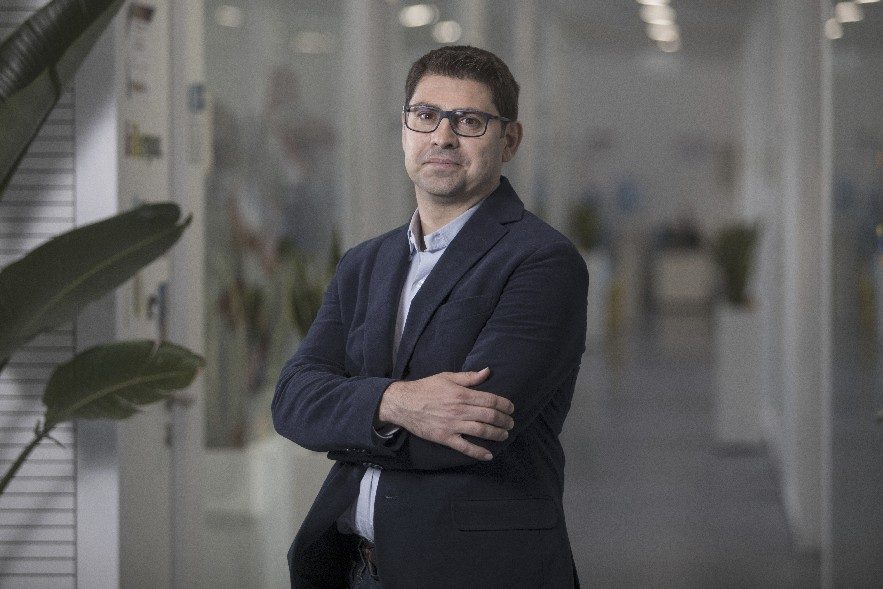"We'll be able to use artificial intelligence to personalize treatments for children with neurodevelopmental disorders"
Llorenç Andreu, lead researcher at the Cognition and Language Research Group (GRECIL), which is affiliated to the Neurodevelop eHealth Lab at the eHealth Center
These are times of very intense work for the Cognition and Language Research Group (GRECIL), which is affiliated to the Neurodevelop eHealth Lab at the eHealth Center and led by the researcher Llorenç Andreu, a full professor in the Faculty of Psychology and Education Sciences. The group has a well-established and united team which is working on various projects focusing on using digital technologies to help children with neurodevelopmental disorders (NDDs). In this interview, Andreu reviews the group's projects and the goals it has achieved.
What would you say were the milestones you achieved in 2022?
2022 was a year of consolidation for our research group. We added people to our team and received recognition as a consolidated research group, receiving funding in various calls, such as the SGR grant from the Catalan University and Research Grant Management Agency (AGAUR). We also received support from the Spanish Ministry of Science and Innovation to carry out the PICOFON project, in which we're going to create an interactive and personalized computer program to help children develop speech and graphically recognize words.
The Emotional well-being and mental health in children with learning disorders project, which was accepted in the La Caixa Connecta call, and the iFONOLOGO project, accepted in the Digital Health Research Promotion Programme of the eHealth Center, also received grants. And we started the two projects for which we obtained national plan funding in 2021: PREVENIR and PROGESPRAG. All of that involved a lot of work establishing contacts with schools, hospitals, associations and families and gathering data.
What are the main challenges involved in collecting and analysing this type of data?
Collecting data with children poses a number of challenges. First, the institutions have to agree to participate in our project. After we have received authorization, we need to coordinate with them to collect data, find available spaces, etc. It's very important to remember that we're collecting very sensitive information from minors, so the security of the data must be paramount. This means it's a complex process, but at the same time it's a very rewarding one because of the contact we have with families, children and professionals.
Are any of the group's projects being applied in clinical and educational practice yet?
Not yet, but some are quite far advanced. For example, there's the PREVENIR project, in which we implemented an oral language intervention programme last year which focused on promoting learning to read in early childhood education, for children with and without language disorders. We're now looking at its benefits for children's language development.
What other projects will lead to a tangible end product?
There's PICOFON, in which we're going to design, create, evaluate and implement an interactive and personalized computer program to improve phonological awareness in children aged three to seven years old. We're currently designing the program, and we're developing body movement and voice recognition systems to apply them in the program.
And there's iFONOLOGO, in which we're creating an artificial intelligence tool for assessment and treatment of speech disorders. We're working on collecting data to be able to train the artificial intelligence (AI) system so that it can recognize speech and classify phonological errors.
Do you think artificial intelligence can have any applications in neurodevelopmental disorders?
Yes, it can help us personalize treatments with these children. For example, in the PICOFON project, which some colleagues from the ADASLab group are involved in, AI will enable the program to adapt to the child's level of response: if they progress, they're offered more complex activities, and if they don't progress, they have to continue working at the same level.
And what stage have you reached in the PROGESPRAG project?
This research studies how children with developmental language disorder and on the autism spectrum process prosody – the rhythmic, accentual and intonational characteristics of speech - and body movements – such as hand and head gestures and facial expressions. We're currently collecting data with the children using eye-tracking methodology.
Another of your projects focuses on the emotional well-being of children with learning disorders. What is your objective?
We aim to produce a diagnosis – for Catalonia – of the emotional well-being and mental health associated with these learning disorders in a post-pandemic context. We're now about to begin collecting data, with the participation of children with developmental language disorder, dyslexia, dyscalculia and ADHD, and their families.
Finally, what are your goals for 2023?
We want to carry out all these projects, and begin the process of publishing the initial data we are obtaining from PREVENIR and PROGESPRAG. We're also involved in collaborations with various research groups and have a great deal of doctoral theses under way, and we hope to be able to publish several articles arising from those. We're also very happy because we're publishing a book about developmental language disorder (DLD) with the Ediciones Pirámide publishing house in 2023. It's a book which people from our research group have been involved with, and which we think will be widely distributed in the Spanish-speaking world.
The eHealth Center investigates how technologies contribute to improving the health and well-being of individuals and groups; how digital health helps us to have more knowledge and a better capacity to make decisions about our health; and how it allows us to strengthen health systems and health professionals through technology, communication and data.
